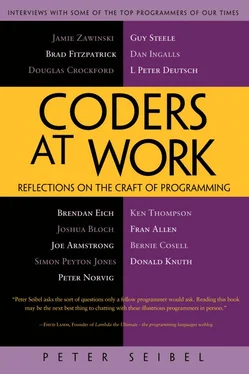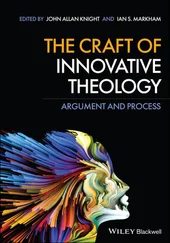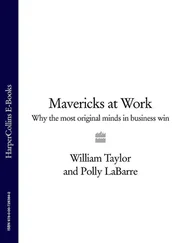Peter Seibel - Coders at Work - Reflections on the craft of programming
Здесь есть возможность читать онлайн «Peter Seibel - Coders at Work - Reflections on the craft of programming» весь текст электронной книги совершенно бесплатно (целиком полную версию без сокращений). В некоторых случаях можно слушать аудио, скачать через торрент в формате fb2 и присутствует краткое содержание. Жанр: Программирование, на английском языке. Описание произведения, (предисловие) а так же отзывы посетителей доступны на портале библиотеки ЛибКат.
- Название:Coders at Work: Reflections on the craft of programming
- Автор:
- Жанр:
- Год:неизвестен
- ISBN:нет данных
- Рейтинг книги:3 / 5. Голосов: 1
-
Избранное:Добавить в избранное
- Отзывы:
-
Ваша оценка:
- 60
- 1
- 2
- 3
- 4
- 5
Coders at Work: Reflections on the craft of programming: краткое содержание, описание и аннотация
Предлагаем к чтению аннотацию, описание, краткое содержание или предисловие (зависит от того, что написал сам автор книги «Coders at Work: Reflections on the craft of programming»). Если вы не нашли необходимую информацию о книге — напишите в комментариях, мы постараемся отыскать её.
Coders at Work
Founders at Work
Coders at Work: Reflections on the craft of programming — читать онлайн бесплатно полную книгу (весь текст) целиком
Ниже представлен текст книги, разбитый по страницам. Система сохранения места последней прочитанной страницы, позволяет с удобством читать онлайн бесплатно книгу «Coders at Work: Reflections on the craft of programming», без необходимости каждый раз заново искать на чём Вы остановились. Поставьте закладку, и сможете в любой момент перейти на страницу, на которой закончили чтение.
Интервал:
Закладка:
Deutsch:When I was 14, I found my way to the TX-0 and to the PDP-1 shortly thereafter. I remember getting a hold of a copy of the Lisp 1.5 programmers’ manual. I don’t remember how. It was a very early version—it was actually mimeographed—the old purple ink. There was something about Lisp that caught my imagination. I’ve always had a kind of mathematical bent, and Lisp just seemed sort of cool. I wanted to have one to play with and I couldn’t get my hands on the Building 26 mainframe. So I did my Lisp implementation on the PDP-1.
Seibel:Do you remember at all how you designed your PDP-1 Lisp?
Deutsch:I’m smiling because the program was so small. Have you seen the listing? It’s only a few hundred lines of assembler.
Seibel:I’ve seen it; I didn’t try to understand it. Was it just a matter of transliterating the thing in the 1.5 manual into assembly?
Deutsch:No, no, no. All that was in the 1.5 manual was the interpreter. I had to write a reader and tokenizer and I had to design the data structures and all that stuff. My recollection was that I did that the way I actually have done most of my programming, which is to do the data structures first. When I was young enough that my intuition would point me in the right direction—I won’t say infallibly, but close enough—that was a really good approach.
In the last couple of years I’ve noticed that I’ve gotten rusty—my intuition doesn’t work so well anymore. I’ve been doing a substantial project off and on for several years now to do a good open-source music score editor. I’ve been fiddling with that off and on for several years now and I find that letting my intuition steer me to the right data structures and then just writing everything out from there just doesn’t work anymore.
Seibel:Do you think your intuition is actually worse or did you used to have more stamina for making it work even if your intuition was actually a bit off?
Deutsch:I think it’s some of each but I think it’s more the former. I think what intuition is, really, is an unconscious process for synthesizing a solution out of a large amount of data. And as I’ve gotten further and further away from being immersed in the stuff of software, the data that goes into that synthesis has become less and less accessible.
I’ve heard it said that to be a master at something you have to have, pretty much at your command, something like 20,000 specific cases. What’s happened is the 20,000 specific cases of software design that passed in front of my face in my 45 years in the industry are just gradually becoming less and less accessible, the way memories do. I think that’s pretty much what’s going on.
Seibel:Do you remember what it was about programming that drew you in?
Deutsch:With the benefit of 50 years of hindsight, I can see that I have always been drawn to systems of denotative symbols—languages. Not only languages of discourse—human languages—but languages in which utterances have effects. Programming languages certainly fall right into that category.
I think that also has something to do with why the career that I’ve switched into is musical composition. Music is a language, or a family of languages, but what you say in those languages not only has denotation, maybe, but it also it has effects on people. Music is kind of interesting because on the spectrum of formality it falls between natural languages and computer languages. It’s more formal and structured than a natural language, but it doesn’t have nearly the structure or formality of a computer language. That, I think, may have to do with why I went into music and not poetry. I think poetry is not structured enough for me.
But the short answer really is, I just gravitated to this stuff right away.
Seibel:Do you remember the first interesting program you wrote?
Deutsch:The first program that I wrote because the content interested me was actually the second program that I wrote. The first program I wrote was some piece of calculation having to do with the Cambridge Electron Accelerator. The second program was a floating-point-output-formatting program.
Seibel:Which is a pretty hairy problem.
Deutsch:Well it is on a binary machine. It’s not a hairy problem on a decimal machine, and I was working on a decimal machine. You just slide the string around and decide where to put the decimal point. You have to decide whether to use the E or F format. But in those days, everything was a lot harder—I was writing in assembly language on a batch-processing machine—so this was not a trivial problem. It wasn’t a hard problem but it wasn’t a trivial one. That was the first program that I wrote because I wanted to.
Seibel:So you were hanging out at MIT during high school and then you went to Berkeley for college. Did you want to escape the East Coast?
Deutsch:Sort of. I realized that it would be really good for me to go to someplace that was far away from my parents. The three places that I considered seriously were, I think it was University of Rochester, University of Chicago, and Berkeley. That was a no-brainer—only one of the three has reasonable weather. So that’s how I ended up at Berkeley. And it was one of the best things that ever happened in my life.
I was at Berkeley and I found Project Genie pretty quickly after I arrived and stayed with that project until—well there was Project Genie and then there was Berkeley Computer Corporation and then there was Xerox.
Seibel:Presumably at Berkeley you started working on bigger projects than your PDP-1 Lisp implementation.
Deutsch:Oh, yeah. Considerably larger projects at Project Genie. To begin with I wrote pretty much the whole operating-system kernel. The kernel was probably pushing 10,000 lines.
Seibel:How did that change—an order-of-magnitude difference in size—change your design process?
Deutsch:I’m trying to remember what was in the kernel. It was still a small enough program that I could approach it as a whole. There were obviously functional divisions. I know I had a clear mental model of which sections of the program were allowed to interact with which of the key data structures. But in fact there weren’t very damn many data structures. There was a process table; there were ready lists. There were I/O buffers and there was some stuff for keeping track of virtual memory. And then there was an open file table, per process. But the descriptions of all the system data structures probably could have fit on, in terms of C struct definitions, probably could have fit on two pages. So we’re not talking about a complicated system.
Seibel:What’s the biggest system that you’ve worked on that you remember how it was designed?
Deutsch:I’ve been the primary mover on three large systems. Ghostscript—not counting the device drivers, which I didn’t write most of—was probably somewhere on the order of between 50,000 and 100,000 lines of C.
On the ParcPlace Smalltalk virtual machine I worked only on the just-in-time compiler, which was probably 20 percent of it, and that was probably in the low single-digit thousands of lines of C. Maybe 3,000, 5,000—something like that.
And the Interlisp implementation, as much of it as I was concerned with, was probably a couple thousand lines of microcode, and maybe—I’m guessing now—maybe another 5,000 lines of Lisp. So Ghostscript is probably the largest single system I’ve ever been involved with.
Seibel:And other than the device drivers written by other people, you basically wrote that by yourself.
Читать дальшеИнтервал:
Закладка:
Похожие книги на «Coders at Work: Reflections on the craft of programming»
Представляем Вашему вниманию похожие книги на «Coders at Work: Reflections on the craft of programming» списком для выбора. Мы отобрали схожую по названию и смыслу литературу в надежде предоставить читателям больше вариантов отыскать новые, интересные, ещё непрочитанные произведения.
Обсуждение, отзывы о книге «Coders at Work: Reflections on the craft of programming» и просто собственные мнения читателей. Оставьте ваши комментарии, напишите, что Вы думаете о произведении, его смысле или главных героях. Укажите что конкретно понравилось, а что нет, и почему Вы так считаете.












